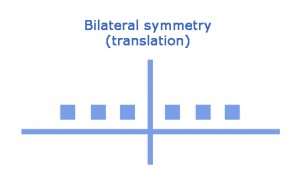Equality – a value built on bilateral symmetry (translation)
 These little squares are symmetrical even when turned 90, 180 or 360 degrees. They can also be interchanged or superimposed. The squares on the left are identical or equal to those on the right. The right ones are equal to the left. This kind of symmetry is the basis of the principle of “EQUALITY ”. This value has been known for two centuries. Unfortunately it has not always been understood correctly because, in reality, individuals are never equals, they are all differents
These little squares are symmetrical even when turned 90, 180 or 360 degrees. They can also be interchanged or superimposed. The squares on the left are identical or equal to those on the right. The right ones are equal to the left. This kind of symmetry is the basis of the principle of “EQUALITY ”. This value has been known for two centuries. Unfortunately it has not always been understood correctly because, in reality, individuals are never equals, they are all differents
Today we understand this principle as an “equal right to be” ie we are all equal before the law. This is the foundation of our justice system.
During the French revolution 1789 and for more than a century the principle of equality was perceived as a need to equalize the fortunes i.e. to take from the rich and give to the poor like “Robin Hood” who was a bandit. The hatred of the rich and social inequalities generated violence and hope that led to a permanent confrontation between « libertarians » and “egalitarians”. After over a century of tensions it finally gave birth to communism and its opponent neoliberalism. These two ideologies have bloodied the planet and have never been reconciled; their foundations were problematic, they were mistaken about the meaning of freedom and equality.
To take the good from Peter and to give it to John is not an “ethical” behavior: One cannot do good on one side and simultaneously do evil on the other side. It is contradictory. In the same way one cannot say a thing and its opposite, it is also contradictory, it is not “true”.
When there are social inequalities, we should not stigmatize human beings, so called enemies, by pointing the finger. This can only lead to hatred and violence. The problem of social inequality comes from the powers that be. The rich get richer because too often our laws are discriminatory. They are made to protect old privileges, sometimes in the name of safeguarding jobs or fear of competition.
The right to be, to live, to blossom and to reproduce is given to us at birth and it applies to us as well as to others; it is therefore equal for all and aims at the life, the survival and the future of beings.
This right to be, based on the physical laws of nature, is not an absolute right; it can be revoked at any time by the same natural laws that gave us life: by accidental death or simply by natural death.
Equality before the law i.e. the right to be should not be confused with “equality of situation or the right to have which is a utopia: Beings are born different, evolve differently and they claim their differences because they give them an identity. Human beings have a right to be, to live and to become which is equal to that of the other beings, but it is also the right to be different and to pursue other goals than an insatiable quest for profits or revenge against the haves.
In the same way, we should not confuse the “right to have” (which is utopian) with the “right to property” which applies to things and which is well regulated by societal laws. The right to property implies work or an acquisition, it is not a right given by nature.
Each time when the principle of equality between beings breaks down then discrimination inevitably appears.
One of the by-products of equality is equity. Not to enrich oneself at the expense of others is to respect human beings, their rights and their differences. At a time when social inequalities are exploding, it would be good for our legislators to remember this.
In other contexts, equality produces derivatives such as equivalence, balance, (equilibrium) etc. At a time when trade imbalances generate trade wars, it would be good to remember this too.

